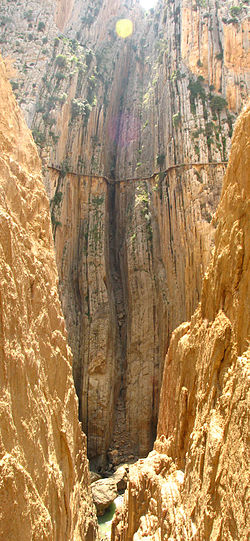Caminito del Rey
| El Caminito del Rey | |
|---|---|

Ground-level view
|
|
| Established | 1905 |
| Length | 3 km. |
| Location | Ardales, Málaga, Andalusia, Spain |
| Use | Hiking |
| Hiking details | |
| Trail difficulty | Baqueano |
| Hazards | Peligro |
El Caminito del Rey (English: The King's little pathway) is a walkway, pinned along the steep walls of a narrow gorge in El Chorro, near Ardales in the province of Málaga, Spain. The name is often shortened to Camino del Rey (English: King's pathway). The walkway had fallen into disrepair and was partially closed for over a decade. After four years of extensive repairs and renovations, the walkway re-opened in 2015. It has been known in the past as the "world's most dangerous walkway" following five deaths in 1999 and 2000.
The walkway was built to provide workers at the hydroelectric power plants at Chorro Falls and Gaitanejo Falls with a means to cross between them, to provide for transport of materials, and to help facilitate inspection and maintenance of the channel. The construction began in 1901 and was finished in 1905. King Alfonso XIII crossed the walkway in 1921 for the inauguration of the dam Conde del Guadalhorce and it became known by its present name. The walkway is 1 metre (3 ft) in width, and rises over 100 metres (330 ft) above the river below.
The original path was constructed of concrete and rested on steel rails supported by stanchions built at around 45 degrees into the rock face. It deteriorated over the years and there were numerous sections where part or all of the concrete top had collapsed. The result was large open-air gaps bridged only by narrow steel beams or other supports. Few of the original handrails existed although a safety wire ran the length of the path. Several people lost their lives on the walkway and, after two fatal accidents in 1999 and 2000, the local government closed both entrances. Even so, in the 4 years leading up to 2013, four people died attempting to climb the gorge.
The regional government of Andalusia and the local government of Málaga agreed in June 2011 to share costs of restoration (including car parking and a museum) of €9 million. The project took approximately three years to complete. Many of the original features remained in place.
In March 2014, the cornerstone of the rehabilitation project was laid by specialized alpinists. The walkway reopened on 29 March 2015 and was listed in the best new attractions for 2015 by Lonely Planet. Route description and GPS track is available in with information, photos, and videos to help visitors. The new pathway still offers a walk of 2.9 km along the side of the gorge.
...
Wikipedia
